Salter-Harris Classification is used for Growth plate fractures:
Growth plate fractures account for 15-20% of major long-bone fractures and 34% of hand fractures in childhood. The large majority of these fractures heal without any impairment of growth mechanism but some lead to clinically important shortening and angulation. Growth-plate fractures may lead to growth disorders due to destruction of epiphyseal circulation (inhibits physeal growth), or by the formation of a bone bridge across growth plate.
Salter-Harris is a commonly used method of describing fractures through the physis (growth plate) of skeletally immature individuals. Outcome worsens as the number describing the fracture increases.
Salter-Harris Type I: fracture through the physis without involvement of the bone of the epiphysis or metaphysis.
Salter-Harris Type I: fracture through the physis without involvement of the bone of the epiphysis or metaphysis.
- Affects young childhood.
- Growth plate is thick.
- Large hypertrophying chondrocytes.
- Weak zone provisional calcification.
- Mechanism: shear or fracture lines follow growth plate, separating epiphysis from metaphysis.
- Unless the periosteum is torn, displacement usually does not cannot occur (many locations do not have periosteum).
- Without displacement radiographs appear normal.
- Healing is rapid, usually within 2-3 weeks.
- Salter-Harris Type II: The most common type of Salter-Harris fracture, a type II fracture. occurs through the physis and metaphysis; the epiphysis is not involved in the injury.
- Occurs after age 10.
- Mechanism: shear or avulsion with angular force.
- Cartilage failure on the tension side.
- Metaphyseal failure on the compression side.
- With type II fractures, there is a division between epiphysis and metaphysis except for a flake of metaphyseal bone carried with epiphysis (Thurston Holland sign).
- Healing is rapid, and growth is rarely disturbed.
- Note: Type II fracture of distal femur and tibia may result in growth deformity.
- Salter-Harris Type III: A type III fracture is a fracture through the physis and epiphysis. This fracture passes through the hypertrophic layer of the physis and extends to split the epiphysis, inevitably damaging the reproductive layer of the physis.
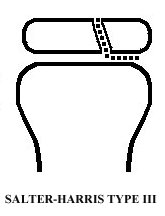
- Usually occurs after 10 years.
- This type of fracture generally occurs when the growth plate is partially fused.
- Prognosis is poor unless there is early accurate reduction.
- Type III physeal injuries involve separations of portion of epiphysis and its associated growth plate from the rest of the epiphysis.
- Salter-Harris Type IV: A Type IV fracture involves all 3 elements of the bone, passing through the epiphysis, physis, and metaphysis.
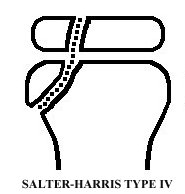
- Rare in the hand. Most common sites include the lateral condyle of the distal humerus in patients under 10 years of age and the distal tibia in those over the age of 10.
- Type IV fractures potentially interfere with normal growth.
- Fracture line crosses physis, separating a portion of metaphysis-physis-epiphysis from the remaining metaphysis-physis-epiphysis.
- If fracture is displaced, open reduction and internal fixation is indicated.
- Even with perfect reduction, growth is affected and prognosis is guarded.
- Salter-Harris Type V: A type V injury (illustrated below) is a compression or crush injury of the epiphyseal plate, with no associated epiphyseal or metaphyseal fracture.
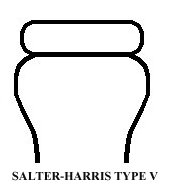
A power point presentation on Salter Harris Classifiaction:
https://www.box.com/s/4kil2oodppfh9o7n0fq1
Some nice X-Rays are available on e medicine on Salter Harris Classification:http://emedicine.medscape.com/article/412956-overview
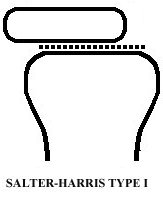
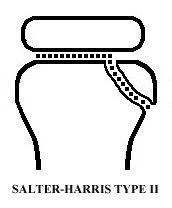
Note: only a member of this blog may post a comment.